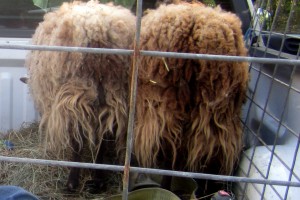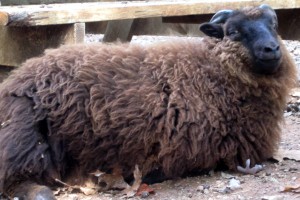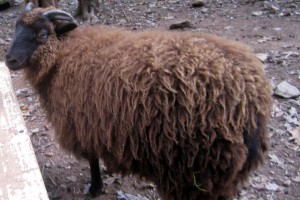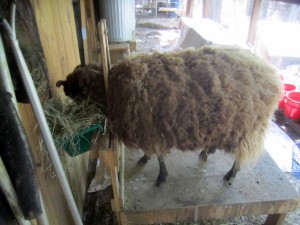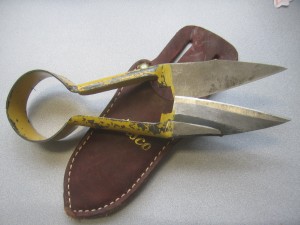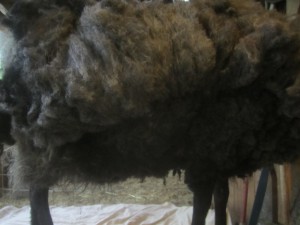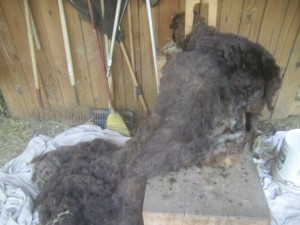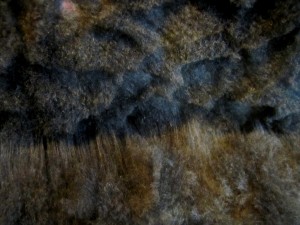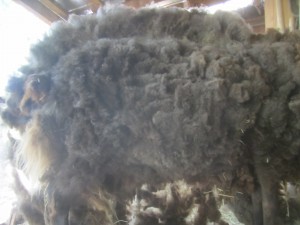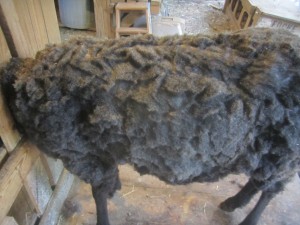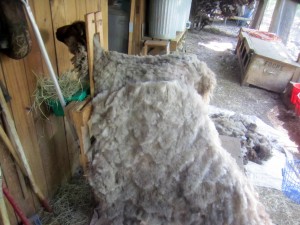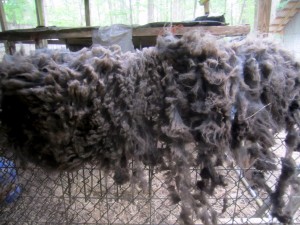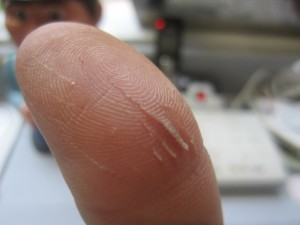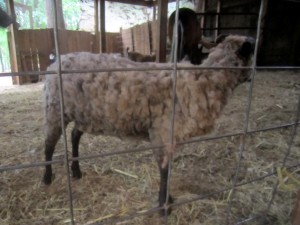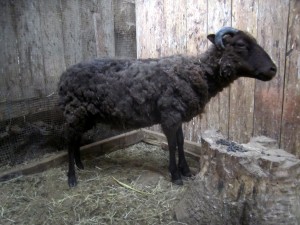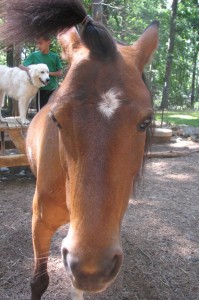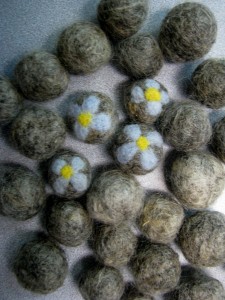Second Cuts: A Guide to Shearing Your Sheep For Felting.
Posted on | July 8, 2014 | No Comments
I forgot to tell you that I sheared the sheep. I forgot to tell you because it happened this spring when we were busy with fishing and farm tours, strawberries and sports award banquets, birthdays and brooder room set-up. So much was happening at once that I was forced into reactive mode instead of proactive mode. Not to say that we are usually proactive around here. We’re not. There’s way too much procrastinating around here to be considered proactive. But at least I can say I am usually forced to be reactive because my time and energy is always consumed with unplanned emergencies—a kid home sick from school, a deer deciding to take out the front fender and headlights on the car, pasty butt on the chicks, Colorado potato beetles spreading from the potatoes to the eggplant, finding out it’s Dollar Day at the Goodwill only when I drive by and see the overflowing parking lot and line of people around the building, etc.
This spring the emergencies couldn’t even compare to all the preplanned events that were eating up my time. Why did I think 4 kids in 4 different sports was a good idea? Why? Why? So it wasn’t until we were on farm tour that I realized everyone’s sheep, except for mine, had already been sheared. I mean, everyone’s sheep. There were NO unsheared sheep. Even the hair sheep had been trimmed to keep them comfortable in the rising temperatures. As a matter of fact, most of the sheep had been sheared so many weeks earlier that their fleece was already growing back. It was embarrassing.
I had noticed that my sheep were starting to look like bath mats from behind….
….but I didn’t notice it until I was quickly feeding the animals before dropping Pretty off at volleyball, picking up Big from lacrosse, getting Middle into his baseball uniform before The Other Half got home from work and rushed him to his game, taking Little to soccer, and frantically calling my parents to let them know which child had been left stranded where and needed to be rescued and carried on to the next activity. So there wasn’t much I could do about it at the time.
I was determined to shear my sheep myself. I learned shearing from an experienced shearer. I knew about positions and unzipping the wool and first and second cuts. I knew about clippers and blades and cuts and grazes. I also knew I wasn’t going to buy an expensive pair of clippers. And I knew that I wanted to try shearing without the motor and the noise and the danger of the clippers taking off huge chunks of skin (my skin or the sheep’s skin). So I borrowed a pair of hand shears and reviewed some shearing sites.
While I was reviewing the sites and their accompanying photos, I remembered how much my back hated the proper positions of sheep shearing. Plus, I remembered how similar the positioning of the sheep was to wrestling with the sheep. Also, I remembered that shearing is best with an assistant to help:
1. Wrestle Herd the sheep into a containment pen.
2. Wrestle Position the sheep during shearing.
3. Keep the tarp/sheet/plywood in place that is protecting the fleece from the dirty barn floor. That’s because the tarp/sheet/plywood is sure to get knocked out of place during the wrestling positioning of the sheep.
4. Toss the soiled bits of wool (i.e those soaked or encrusted with urine, poop, or disgusting unidentified debris) off the tarp/sheet/plywood so that it doesn’t get mixed with the good, clean fleece during the wrestling positioning of the sheep.
With The Other Half at work and the children still in school, waiting for an assistant was likely to push the 2014 shearing into 2015. So I did what any dairy goat farmer who happens to incidentally own sheep would do. I put those woolies on the milk stand.
There is a special relationship between a dairy goat farmer and her milk stand. The milk stand is a sacred tool for a dairy goat farmer. It is for milking, trimming hooves, giving shots, applying DE, and, occasionally, holding a doe still for breeding. Or around here, a step stool for the little bucks to reach the big does during breeding. It is for sitting on, keeping tools arranged on while working on a barn task, and stacking buckets or supplies when not in use. It is the ultimate jungle gym for goat kids during kidding season. It is even a roost for the annoying Silkie pair that insists on sleeping (and pooping) on it every night, regardless of how I try to block off their access. A dairy barn just isn’t a dairy barn without a milk stand.
And if what’s good for the goose is good for the gander, then what’s good for the goat is good for the sheep. Probably. Maybe. Eh.
I started with Isaac and Simon.
Since they were raised here as bottle fed lambs they are extremely gullible. They don’t know that sheep are normally skittish and standoffish. They think normal means a chin rub every morning and wagging your tail when you get a good chest scratch. They assume other sheep ride in the back of the truck, follow the farmer back into the barnyard after the goats lead everyone out during an escape, and wait patiently outside the garden for the weeds to be thrown over the fence. They don’t even mind a horn trim with the tree clippers.
Suckers.
Sure enough, all it took was handful of hay to convince them to climb onto the milk stand.
Suckers.
Then I just picked up my borrowed shears….
had a seat on the 5 gallon bucket milk stool, started at the bottom of the sheep’s belly….
and worked my way right over the top.
Getting started was a bit sketchy. Differentiating between the muck that needed to be clipped off from the genitalia that was best left in place was kind of tricky from the milk stool position. But once I arrived at the top of the sheep’s back, I was in standing position and the weight of the wool pulled the fibers quite tight and away from the skin for easy shearing.
Oh, to be sure, it was a study in second cuts.
And some received a more bizare hack job than others. For no known reason. I felt like I was shearing Samantha the same as everyone else. But apparently my subconscious was thinking, “Wouldn’t zig zag look nice for spring?”
In spite of everything, the sheep looked quite majestic as they shed that winter wool.
Plus, each fleece came off in a single, complete, hangable, washable, baggable piece.
The only injuries were to the thumb I used for blocking the shears when working around thick mats or sensitive areas. By keeping my thumb just in front of the blade when I couldn’t see clear to the skin, I ensured it didn’t go down into the flesh but stayed close to the surface.
There’s an obvious market for sheep shearing thimbles. Among dairy goat farmers. Who shear their sheep on the milk stand. Why am I always part of the overlooked niches in farming? Is it me? Really??
Anyway, the sheep might have looked goofy with their home haircuts….
but they were nice and cool for summer.
Besides, we’ve had worse DIY hairstyles around here.
And Little’s mohawk was leading him to a goal-scoring soccer season.
So what’s the matter with a unique haircut between friends and family? And livestock.
Overall, I was pleased with my efforts. Of course, I am easily pleased with myself. It’s one of the secrets to my success.
And if the wool was unsuitable for spinning, it was perfect for felting. I have several projects planned that advise starting with large amounts of “waste” wool and saving the expensive dyed roving for the just the top layer. In the meantime, needle felting the wool into beads for future decoration is a perfect way to spend the slow times during Saturday mornings at the farmers market.
So perfect that several customers asked to buy “waste” wool for their own projects after washing me card and felt while sitting at the table. Which means I actually sheared my sheep at exactly the right time. I wasn’t too late after all.
I know, people.
Sometimes I even amaze myself.
Comments

Leave a Reply
